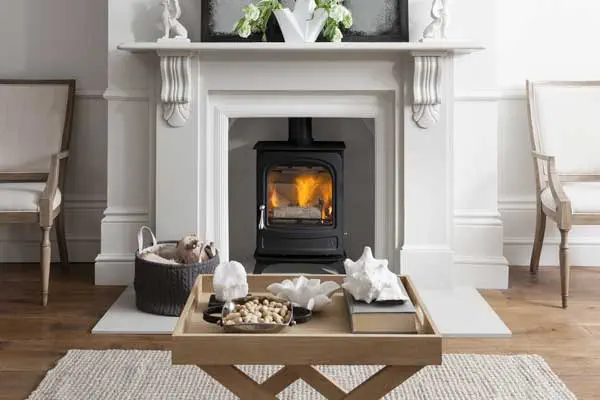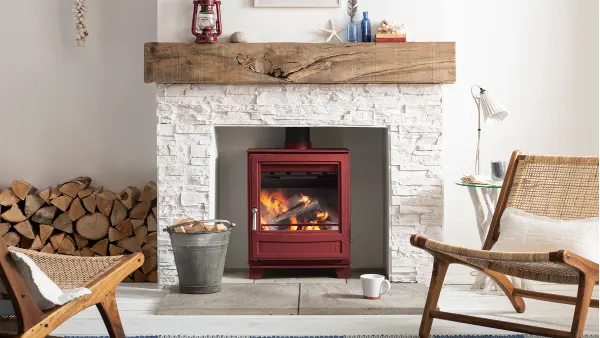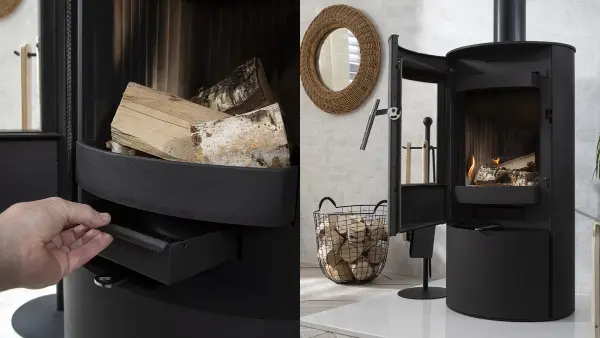Why is a wood burner better than an open fire?
Have you been thinking of replacing your open fire with a wood burner? Read on to find out the benefits of adding a stove to your home.
Are wood burners better than open fires?
Are you not sure what side to take on the wood burner vs open fire debate? There are many reasons why making the switch from an open fire to a stove is not only better for the environment, but better for your health too! We look at what you need to know to make the right choice for your home.
How does a wood burner work?
In principle, a wood burner is an open fire but it’s a fire that is constrained to a ‘fire chamber’. The heat from the flames is radiated out into the room from the stove body itself, as well as out through a flue – which is either run up through a pre-existing chimney or via a freestanding flue.
The action of heat leaving the flue outside creates a draw of air from the room where the stove is situated, where in some cases, air can be drawn in from outside of the property. It is this draw of air that continues to pull more oxygen into the fire chamber that in turn feeds the flames.
Thinking about a wood burner?
Thinking about installing a wood burning stove but are not sure where to begin? Read our blog on what to know about getting a stove in your home to get you started.

How does a wood burner differ from an open fire?
On the above basis, it appears that a wood burning stove is very similar to an open fire. However, there are several important differences to be aware of!
- Wood burning stoves offer far better fuel efficiency and longer burn times with the same amount of fuel, compared to an open fire, as a stove can manipulate the air flow into the fire chamber.
- A stove is better for public health and the environment in comparison to an open fire as a stove can reburn any particulates (PM2.5 particulates too) that could be emitted – another factor that increases fuel efficiency. Our stoves also use the heat recirculation phase to maximise the enjoyment of the flame view by creating an ‘airwash.’ This works by forcing hot air in the chamber down over the inside of the door glass to clear it of any unburnt material.
- Wood burning stoves are safer by containing the flame and not allowing smoke to enter the room, which cannot be said of an open fire. That being said, a small amount of smoke will still enter the room when a stove door is opened and closed. For safety, you should never open the stove door to flames anyway and wait until the you can clearly see embers before refuelling.
- Wood burning stoves are designed to fit a typical modern-era fireplace, but many models don’t even require a pre-existing chimney, which means there is more flexibility on where to run the flue and to install. An open fire needs a pre-existing chimney and fireplace.
- Wood burning stoves are easier to control and shut down before retiring to bed, whereas an open fire will continue drawing air from combustion as there is no way to limit it.
- Open fires are known to make the rest of the house colder because of the amount of air they need to consume, including most of the warm air in the room which the fire is creating. The majority of wood burners, especially above 5kW as required by building regulations, need a cold air vent to supply cold air for combustion. In many homes, this vent can connect directly from the stove to the outdoors, meaning cold air is not pulled in from the rest of the room and house.

Are there strict regulations in place for wood burners?
The development of wood burning stove technology is ongoing and all manufacturers of wood burning stoves are bound by these regulatory measures. Since 2020, we have developed stove models that meet the strict EU legislation (often referred to as ‘Ecodesign’) to hit two key targets - firstly, to offer ever-increasing fuel efficiency and secondly, very low emissions, especially the reduction of PM2.5 particulates.

Find out more
If you would like more technical advice about your installation needs, speak to your local Arada retailer. They can conduct a property survey and walk you through the optimal stove appliance, and any additional options such as prefabricated flues or direct air kits.
Find your nearest Arada stove retailer here and ask them about Arada's ecodesign stoves
Related Articles
Installing a Stove
- Wood Burning Stove Outhouse Install - Humphrey & Grace Collaboration
- Can I Install a Small Wood Burning Stove in my Shed?
- Combustibles distance - How much space to leave around a wood burner?
- No chimney? No problem!
- The 2022 Stove Legislation - What do I need to Know?
- Distance to Combustibles - Clearance to Combustible materials or How much
- Can I Install a Stove In A New Build Home?
9th February, 2024.
